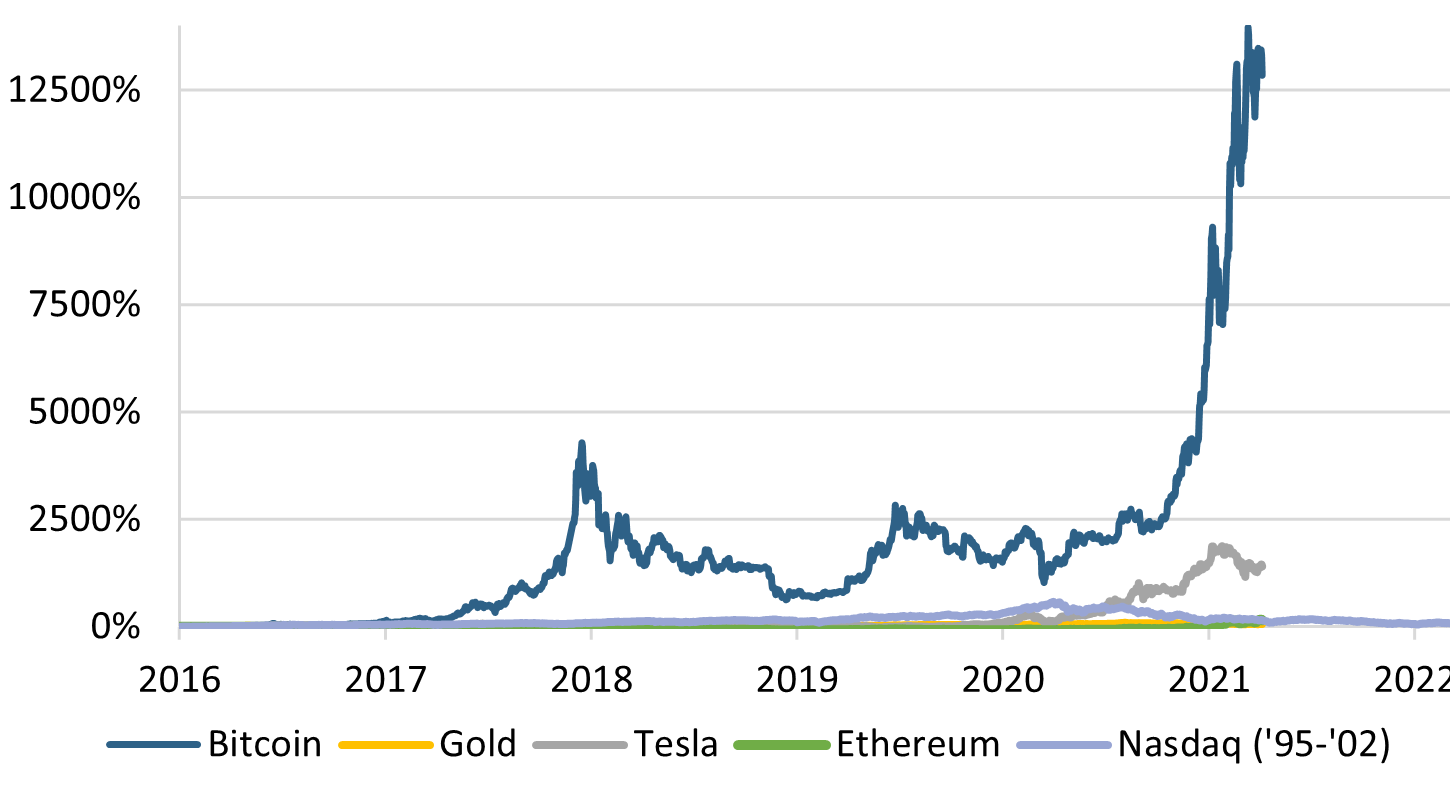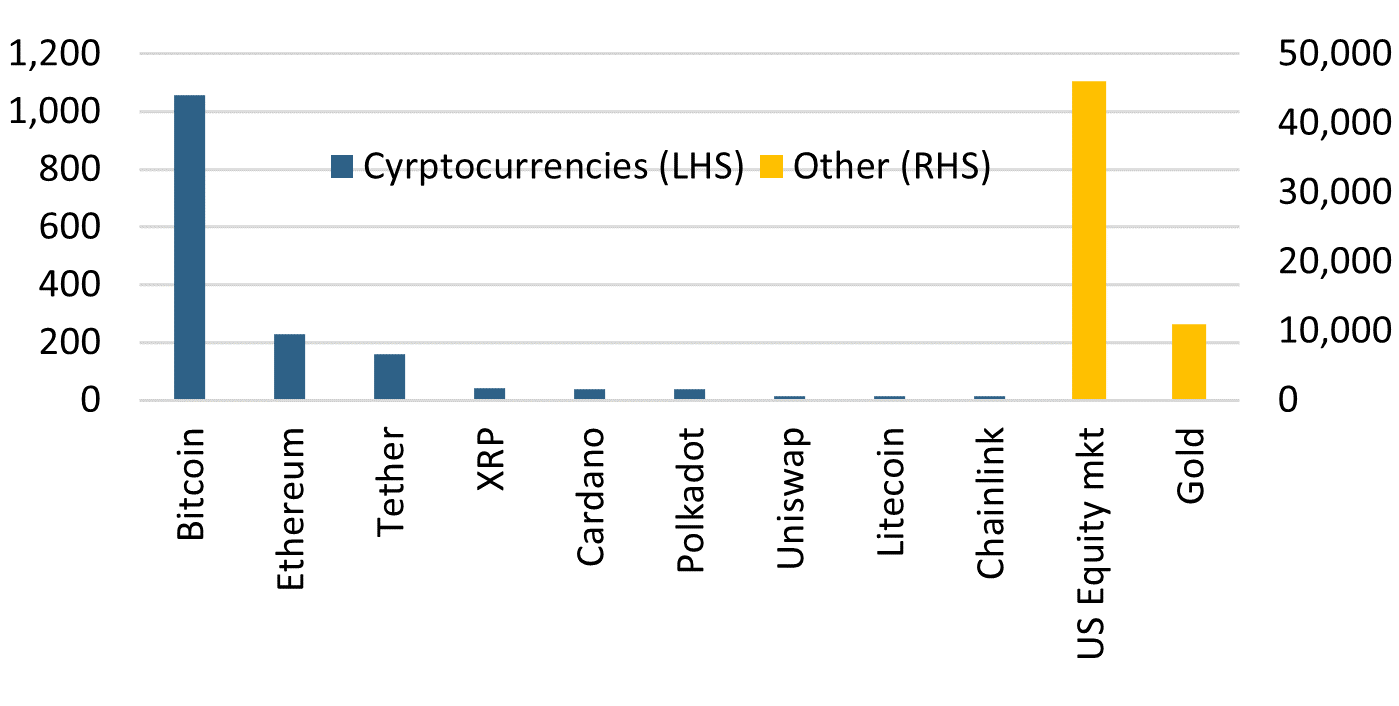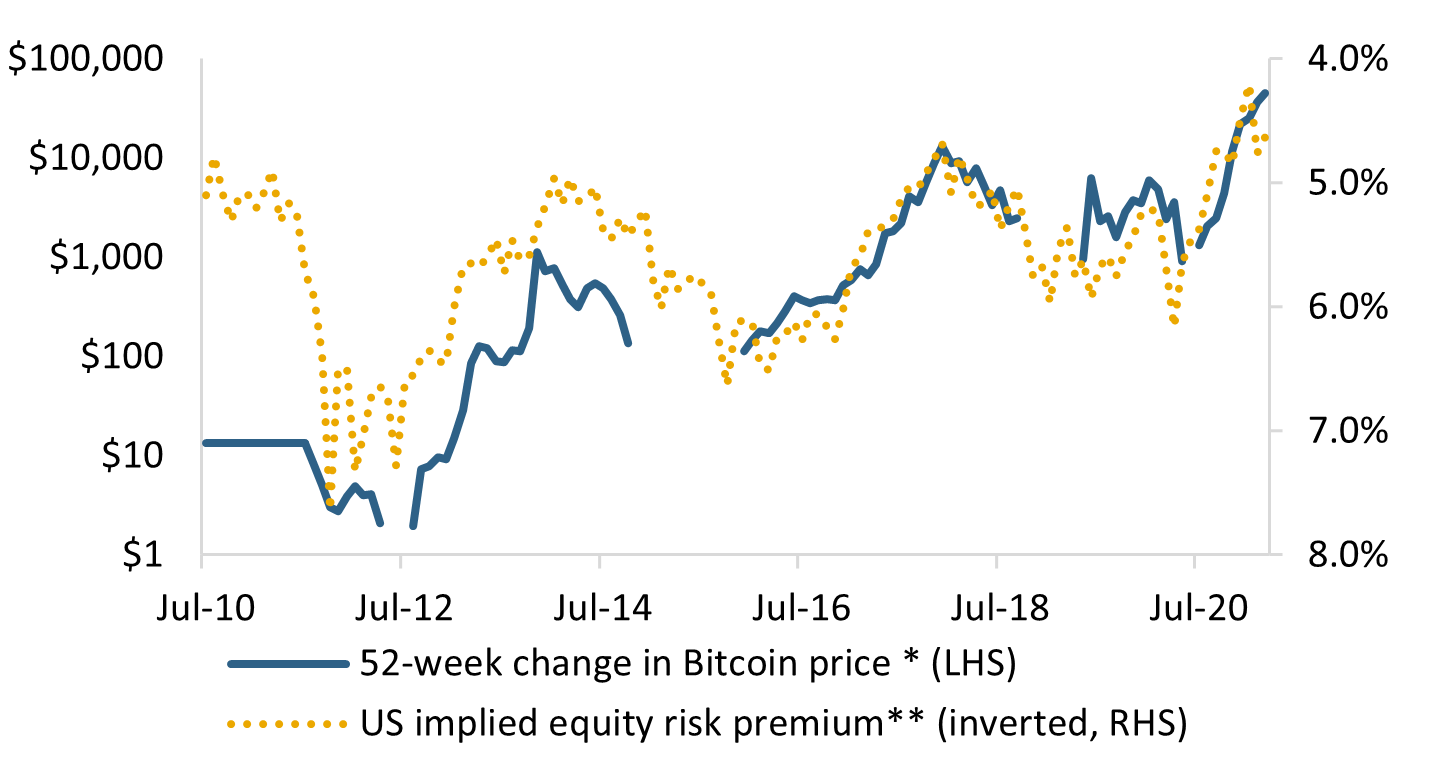How should we think about cryptocurrencies?
Cryptocurrencies are once again capturing investors’ attention. Bitcoin, the sector leader, is attracting significant institutional capital and increasingly being accepted as a method of payment by global consumer companies. Greater regulatory attention and efforts by central banks to create their own digital currencies is also providing some legitimacy to this digital space.
The opportunities for investors to research and read about the rise of cryptocurrencies seems almost endless and extends from trying to understand the nature of the potential investment through to ascertaining its ‘fair value’. In this article, we focus on some, though by no means all, of the key questions being asked.
For those who judge an allocation to cryptocurrencies a worthy investment, from either a risk management perspective or a strong belief in the long-term opportunity, we make several observations. These include where cryptocurrencies should sit in a diversified portfolio and the size of an appropriate position.
What is it? Should we like it?
Let’s focus firstly on Bitcoin as the leader in the sector. And to be clear, no amount of words in this note can adequately convey the depth of commentary and research in this space. But Bitcoin’s origin stems from Satoshi Nakamoto’s seminal ‘whitepaper’ in 2008. Today, as Galaxy Fund Management describes, “the Bitcoin blockchain can best be thought of as distributed software that allows for the transfer of value via its native digital asset, Bitcoin, without relying on third parties.” For advocates, this translates to a form of electronic or digital cash that allows peer-to-peer transactions where there is ultimate trust, security and transparency in the absence of a third party (like your bank).
There is little debate about the ‘potential’ uses for cryptocurrencies (and non-fungible tokens, known as NFTs) as we increasingly evolve from a physical to a digital world. Advocates also argue Bitcoin is more attractive in the current environment where there is concern regarding fiat (or paper) money’s ability to hold its value, given zero interest rates and unconstrained money printing by central banks. Distrust of governments and banks has been flagged as a driver of demand for cryptocurrencies. More positively, there is less debate over the potential for crypto technology to facilitate decentralised, secure and anonymous transactions via blockchains in a way that has material societal applications.
We should also note that Bitcoin and other cryptocurrencies are not universally loved. AlpineMacro retorts that “Bitcoin was created out of thin air and will likely disappear like mist. Although Bitcoin prices have been skyrocketing, the crypto mania is nothing more than a modern version of the tulip bubble”. Northern Trust Chief Economist, Carl Tannenbaum, argues that “in short, the arguable lack of real-world use cases that are ‘essential’ does make it difficult to estimate a ‘fair value’ for Bitcoin and other cryptocurrencies (of which there are over 4000).”
Crypto asset prices have risen sharply in 2021

Source: Bloomberg, Crestone.
There are a plethora of questions about the rise of cryptocurrencies. We address a few of these below, including whether it is digital gold, a store of value, just a commodity, and if it can be a means of exchange. We also touch on the vibrant debate around Bitcoin and sustainability, as well as key observations on whether Bitcoin and other cryptocurrencies have a place in diversified portfolios.
Are cryptocurrencies a store of value?
They could be in time. As we have noted elsewhere, zero central bank policy rates are more likely to drive asset price inflation than consumer inflation. Another way to think about this is that asset prices (say, property or gold) have a constant intrinsic value, and the seemingly unconstrained printing of money is merely debasing fiat currencies (i.e. increasing the amount you need to buy the same physical asset). The question is whether cryptocurrencies (which have been rising in price) can better hold their value. Are they a so-called form of ‘digital gold’?
Supporting this, advocates note that Bitcoin (more so than some other cryptos) has a scarcity element much like, but greater than, gold. Keen investors favour the fact that Bitcoin’s supply cannot be expanded, allowing its supply schedule to be known. There are currently 18.7 million Bitcoins, and its design prohibits expansion beyond 21 million. Estimates suggest the last coin will be ‘mined’ in 2140. The capitalisation of Bitcoin is USD 1.1 trillion, compared to USD 46 trillion for the US share market and USD 11 trillion for gold. This scarcity value could certainly be a long-term positive if demand for its use requires its price to rise exponentially. If its price does not rise, it could present challenges for monetary systems if supply cannot expand in line with the global economy’s growth. Moreover, while Bitcoin is scarce, the supply of many other cryptocurrencies is infinite!
A true store of value is widely considered to be:
- liquid
- universally accepted and
- stable.
Cryptocurrencies are arguably liquid. However, for now, they are not universally accepted for payment or considered by all to be a store of value.
Comparing cryptocurrencies market capitalisation (USD billion)

Source: CoinMarketCap.com, Bloomberg, Crestone.
The main challenge to Bitcoin’s claim to be a store of value is its volatility (and scarcity can contribute to that). As AMP Capital recently noted, “over the last 10 years, the volatility of Bitcoin is 15 times the US share market, 12 times greater than gold and 18 times more volatile than the AUD/USD exchange rate”. Of course, stability could emerge if Bitcoin became a legitimate ‘next generation’ medium of exchange, though typically, stability would be needed for that.
Is it (just) a digital commodity?
The price of commodities tends to be captive to quite well-understood cycles of demand and supply. Commodities are utilised less by investors (than say private equity or other real assets) as they typically have a higher risk and lower average return profile. They do, however, provide a low correlation to more traditional bond and equity investments and can be traded successfully for return. Of course, while most investors seek to access commodity exposure through non-deliverable futures, trading in commodities can still involve physically owning these assets, which can incur storage and holding costs.
Proponents of Bitcoin argue it is a form of digital gold. Like gold, it is borderless, has no centralised control oversupply, is recognised globally, verifiable, and its supply is limited. Similarly, both, after mining deliver investors no income stream. Moreover, it is argued Bitcoin has advantages, given its low relative storage costs and ease of transport. Bitcoin, though, still has a degree of complexity in its own storage and security (though physical costs are much less).
Of course, others also argue that, in contrast to gold, Bitcoin has no real-world practical use—for production or consumption.
Can cryptocurrencies become a means of exchange?
Is Bitcoin money or a medium of exchange? Given the limited number of coins available, the fact it has become much more easily divisible certainly works in its favour. And for the vast array of cryptocurrencies generally (with Ethereum the second-largest by market capitalisation behind Bitcoin), the impact of the COVID-19 pandemic has certainly reduced the attractiveness of fiat (or paper) money.
There are, of course, several challenges. In terms of its day-to-day use, the casual observer will conclude that Bitcoin’s usage remains relatively low at the moment. However, in some countries and for some types of goods and services its usage is rapidly rising, particularly on platforms such as PayPal and Square. Indeed, in its Q4 report, Square noted that its cash app—a peer-to-peer payments platform for trading stocks and sending and storing money—generated USD 1.76 billion of Bitcoin revenue, more than 10 times its Bitcoin-related transaction revenue a year ago. It is also now being accepted by Microsoft and Home Depot.
Another challenge is the relatively high cost and slow speed of transactions. Visa systems can process 25,000 transactions per second. But Bitcoin can currently only transact at four per second (leading some to refer to it as ‘tap and slow’). The volatility of cryptocurrencies also bears mention here too, as not only is it a headwind to them being trusted stores of value, the lack of stability and sharp day-to-day price moves make utilisation for frequent purchases impractical.
Finally, we are increasingly seeing global central banks developing their own digital currencies (CBDC). Like governments, they have a strong interest in supporting traditional currencies that they either manage or derive tax revenue from (raising the spectre of increased regulatory focus and outright banning of cryptocurrencies, as has been the case to a degree in the UK). Could these ‘official’ digital assets displace private cryptocurrencies? Advocates argue to the contrary, taking the view that engagement by central banks (like institutional investment) legitimises the existence of these digital assets.
Only in time will we see whether there can be an increase in cryptocurrencies’ usage for more day-to-day transactions that challenge the convenience of paper money—or indeed its ‘tap and go’ equivalents.
Can Bitcoin pass the sustainability test?
The cost of mining bitcoins is also rising exponentially. So, it is not surprising this has captured the ire of those with an eye to the world’s current climate crisis.
As Janet Yellen, new US Treasury Secretary recently noted, “I don’t think that Bitcoin is widely used as a transaction mechanism…it’s an extremely inefficient way of conducting transactions and the amount of energy that’s consumed in processing those transactions is staggering.”
Indeed, according to Digiconomist, one bitcoin transaction is “equivalent to the carbon footprint of 735,121 Visa transactions or 55,280 hours of watching YouTube”. In a recent International Electricity Association report, it estimated that “Bitcoin mining consumed 100 terawatts annually, or between 0.2% and 0.5% of global electricity consumption.” Estimates suggest nearly 60% of mining occurs in China where coal is still a major source of power.
Anyone who has broached this issue with a Bitcoin aficionado will be aware that some of these comparisons are not entirely fair. In particular, the average Bitcoin transaction is around USD 16,000 compared with USD 46 for Visa. Advocates also talk to the potential for the remaining mining of coins to occur with renewables. Time will tell whether such efforts prove credible on a sufficient scale. And, of course, other forms of cryptocurrencies do not suffer from this critique (though similarly, they cannot then claim the same scarcity rights as Bitcoin).
Where could cryptocurrencies sit in a portfolio?
While debate rages over whether cryptocurrencies like Bitcoin are an ‘asset’ worthy of investment, if they were to find a home in a diversified portfolio, where would that be? We believe cryptocurrencies are best positioned in the alternatives, real assets sub-asset class. If cryptocurrencies are an asset (relative to a medium of exchange) then their attributes align most closely to that of gold.
Can cryptocurrencies add positive attributes to a diversified portfolio? There is a range of different analyses showing a relatively low correlation of both Bitcoin and Ethereum to traditional assets. In most cases, correlations are less than 0.2% against equities, broad commodity indexes, gold and exchange rates. Reflecting this diversification, in a recent CFA Research Institute paper, Cryptoassets: The Guide to Bitcoin, Blockchain, and Cryptocurrency for Investment Professionals, it notes that “the median impact of a 2.5% allocation to Bitcoin on a 60/40 portfolio over a three-year period has been to increase total returns by nearly 15%...and boosted the portfolio’s Sharpe ratio by 41%”.
Such correlation analyses could be open to critique given the unstable and relatively immature nature of crypto markets. The relatively steady environment of positive returns since inception could also influence these results. We would also highlight (without denying the low correlations) there does appear to be a noticeably high correlation of Bitcoin with risk appetite, reflected via either the equity risk premium or a weak US dollar trend (see the chart below).
Herein lies another challenge, namely the portfolio design issue of ascertaining what fundamentally drives the ‘fair value’ price of Bitcoin (and other cryptocurrencies)? There is clearly the scarcity element. But could it also be just momentum and risk appetite as the charts below imply? This suggests more time may be needed to understand the true risk and return characteristics of these cryptocurrencies. It will be interesting to see how the price of Bitcoin behaves if we ever return to an environment where interest rates are not zero, noting that Bitcoin began with US 10-year bond yields closer to 4.0% than the 1.5% they are today (this is the lowest in 5,000 years according to Bank of America Merrill Lynch). There is a non-trivial risk that the value of cryptocurrencies could be much less than the market currently assesses.
Bitcoin appears to be a beneficiary of rising risk
appetite

Source: Bloomberg, Crestone.
Concluding thoughts
There are many potential benefits surrounding the innovations associated with the underlying blockchain technology and related applications of cryptocurrencies. For example, Ethereum’s blockchain is programmable, allowing transaction characteristics to be controlled, or so-called ‘smart contracts’ to be embedded.
However, the outlook for Bitcoin, Ethereum and other specific cryptocurrencies are more uncertain. Advocates argue that Bitcoin has already crossed thresholds of liquidity and acceptance. This must be balanced against the challenge of an investment that is intangible, is difficult to explain or conceptualise, and may increasingly be exposed to regulatory risk and rapid (potentially destructive) innovation. It is not always true that the initially dominant player proves the strongest over time (remember Betacam and Myspace). And, of course, some believe cryptocurrencies’ biggest issue is that they have limited real-world use.
But given their rise and developments that would suggest their longevity in some form (including regulatory development, CBDC development, and growing depth of market), investors should arguably take some time to examine and develop their views and understanding. Over time, cryptocurrencies have the potential to check the box of many of their outstanding challenges, from increasing use for day-to-day purchases, reduced volatility, and building trust as a store of value. However, Bitcoin’s ability to solve its sustainability challenges will also be key, and this may be too great a hurdle at present for clients focused on climate change.
We expect the crypto debate to polarise investors for some time to come. For those who judge an allocation a worthy ‘investment’, from either a risk management perspective or a strong belief in the long-term opportunity, we would argue there are several key elements to that investment. In particular, that cryptocurrencies:
- are non-traditional alternatives, and for some time will likely be more difficult to value and be more volatile than typical equities and fixed income assets;
- are not defensive assets and should be viewed as relatively high-risk growth assets within a diversified portfolio; and
- need to be appropriately sized within a diversified portfolio, and like gold, should be viewed as subjective with allocations kept relatively small (likely below 5% of a diversified portfolio).
Finally, where an investment in cryptocurrencies is deemed suitable given an investor’s risk appetite, we suggest exposure should be attained through a mix of passive exposures (likely focused on the key players in the sector, Bitcoin and Ethereum) and blended with a fund managing a diversified exposure to the cryptocurrency sector (to ensure evolving trends can be efficiently recognised).
Alternatively, if viewed through the lens of non-yielding gold, exposure via certain equities that derive an income stream or benefit from cryptocurrency or blockchain technology could also be an alternative means of exposure.
Learn what Crestone can do for your portfolio
With access to an unrivalled network of strategic partners and specialist investment managers, Crestone Wealth Management offer one of the most comprehensive and global product and service offerings in Australian wealth management. Click 'CONTACT' below to find out more.
2 topics

